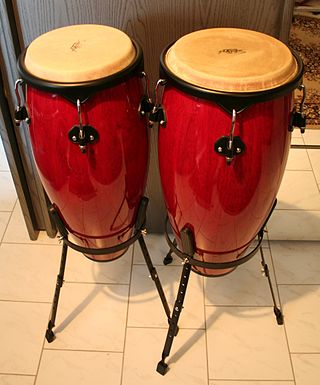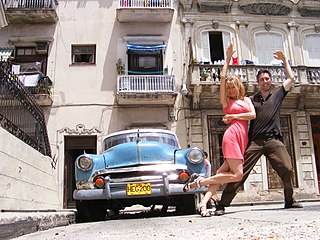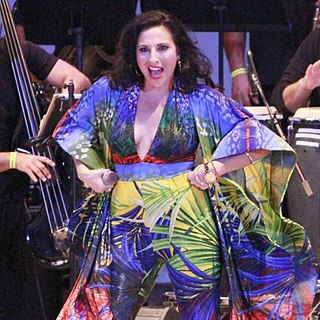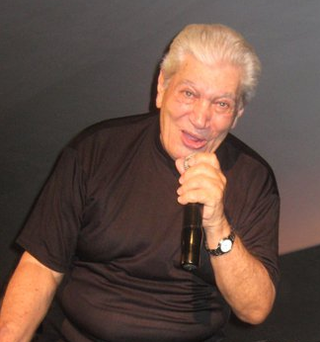Related Research Articles

Salsa music is a style of Caribbean music, combining elements of Cuban, Puerto Rican, and American influences. Because most of the basic musical components predate the labeling of salsa, there have been many controversies regarding its origin. Most songs considered as salsa are primarily based on son montuno and son Cubano, with elements of cha-cha-chá, bolero, rumba, mambo, jazz, R&B, rock, bomba, and plena. All of these elements are adapted to fit the basic Son montuno template when performed within the context of salsa.

The Music of Puerto Rico has evolved as a heterogeneous and dynamic product of diverse cultural resources. The most conspicuous musical sources of Puerto Rico have primarily included African, Taino Indigenous, and European influences. Puerto Rican music culture today comprises a wide and rich variety of genres, ranging from essentially native genres such as bomba, jíbaro, seis, danza, and plena to more recent hybrid genres such as salsa, Latin trap and reggaeton. Broadly conceived, the realm of "Puerto Rican music" should naturally comprise the music culture of the millions of people of Puerto Rican descent who have lived in the United States, especially in New York City. Their music, from salsa to the boleros of Rafael Hernández, cannot be separated from the music culture of Puerto Rico itself.
Charanga is a traditional ensemble that plays Cuban dance music. They made Cuban dance music popular in the 1940s and their music consisted of heavily son-influenced material, performed on European instruments such as violin and flute by a Charanga orchestra.. The style of music that is most associated with a Charanga is termed 'Danzón', and is an amalgam of both European classical music and African rhythms.
Héctor Juan Pérez Martínez, better known as Héctor Lavoe, was a Puerto Rican salsa singer. Lavoe is considered to be possibly the best and most important singer and interpreter in the history of salsa music because he helped to establish the popularity of this musical genre in the decades of 1960s, 1970s and 1980s. His personality, style and the qualities of his voice led him to a successful artistic career in the whole field of Latin music and salsa during the 1970s and 1980s. The cleanness and brightness of his voice, coupled with impeccable diction and the ability to sing long and fast phrases with total naturalness, made him one of the favorite singers of the Latin public.

Orquesta típica, or simply a típica, is a Latin American term for a band which plays popular music. The details vary from country to country. The term tends to be used for groups of medium size in some well-defined instrumental set-up.

Timba is a Cuban genre of music based on Cuban son with salsa, American Funk/R&B and the strong influence of Afro-Cuban folkloric music. Timba rhythm sections differ from their salsa counterparts, because timba emphasizes the bass drum, which is not used in salsa bands. Timba and salsa use the same tempo range and they both use the standard conga marcha. Almost all timba bands have a trap drummer. Timbas also often break the basic tenets of arranging the music in-clave. Timba is considered to be a highly aggressive type of music, with rhythm and "swing" taking precedence over melody and lyricism. Associated with timba is a radically sexual and provocative dance style known as despelote. It is a dynamic evolution of salsa, full of improvisation and Afro Cuban heritage, based on son, Rumba and mambo, taking inspiration from Latin jazz, and is highly percussive with complex sections. Timba is more flexible than salsa and includes a more diverse range of styles. Timba incorporates heavy percussion and rhythms which originally came from the barrios of Cuba.
A descarga is an improvised jam session consisting of variations on Cuban music themes, primarily son montuno, but also guajira, bolero, guaracha and rumba. The genre is strongly influenced by jazz and it was developed in Havana during the 1950s. Important figures in the emergence of the genre were Cachao, Julio Gutiérrez, Bebo Valdés, Peruchín and Niño Rivera in Cuba, and Tito Puente, Machito and Mario Bauzá in New York. Originally, descargas were promoted by record companies such as Panart, Maype and Gema under the label Cuban jam sessions. From the 1960s, the descarga format was usually adapted by large salsa ensembles, most notably the Fania All-Stars.
Salsa Romántica is a soft form of salsa music that emerged between the mid-1980s and early 1990s in New York City, Puerto Rico, and the Dominican Republic. It has been the most commercially successful form of salsa in the last 20 years, despite criticism that it is a pale imitation of "real" salsa, often called "salsa dura".

Tony Vega Cesar is a Puerto Rican salsa singer.

Melina Almodóvar, also known as La Muñeca de la Salsa and La Chica Del Bling, is a Puerto Rican salsa singer, songwriter, dancer, and entertainer. Known for her high-energy performances and salsa dancing skills, she combines old-school salsa moves with contemporary styles of dancing and singing. She established the Orquesta Caliente salsa orchestra in the Southern United States.
This page is a glossary of Colombian music.
Cha-cha-chá is a genre of Cuban music. It has been a popular dance music which developed from the Danzón-mambo in the early 1950s, and became widely popular throughout the world.

Adalberto Santiago is an internationally known salsa singer.
Jimmy Bosch, also known as "El Trombon Criollo", is a jazz and salsa music trombonist, composer, and bandleader of Puerto Rican descent born in Jersey City, New Jersey. He was raised in Hoboken, New Jersey, and graduated from Hoboken High School in 1975.
La Palabra is an American bandleader, singer-songwriter, pianist, record producer, and arranger, known for his versatile approach to music, particularly his invention of the Salsa romantica Latin music genre and his signature style of Afro-Cuban-influenced, sensual Latin jazz.
La Excelencia is an eleven piece salsa dura band from New York City founded in 2005 by percussionists Julian Silva and Jose Vazquez-Cofresi. The band's music has a salsa dura style, with themes incorporating immigration, poverty, and discrimination. La Excelencia recorded and released three albums in their first seven years. The group disbanded in 2012, with Vazquez-Confresi and some of the membership reforming as Orquesta SCC. The band reunited in 2017 under the direction of Silva to start working on their 4th album, "Machete."

Orquesta La 33 is a Colombian salsa music band. The collective was founded in Bogotá in 2001 by brothers Sergio and Santiago Mejía. The name is taken from the city's Calle 33, in Teusaquillo, the 13th locality of Bogotá, where the band first rehearsed.

Salsa Big Band is the fourth studio album by Rubén Blades and Roberto Delgado & Orquesta, released on 29 April 2017 by Rubén Blades Productions. After the release of Son de Panamá in 2015, also recorded with Delgado & Orquesta, Blades decided to record another album with them, on which included eleven songs. He had previously recorded nine on the songs, and two were covers of songs written by Luis Demetrio and Rene Touzet. Delgado was the producer for the álbum. Blades' principal inspiration for the album was his admiration for the work of Puerto Ricans performers such as Tito Puente, Tito Rodríguez and Willie Rosario, and the big band sounds of the 1950s.
Jose Vazquez-Cofresi is an American conga drummer, bandleader, composer and producer of Puerto Rican & Italian ancestry. He is also called Manos de Hierro, literally translated ‘Iron Hands’, a name given to him by a salsa bass player. Throughout his career as a percussionist, he has played a wide variety of Latin music styles. The first composition by Vazquez-Cofresi that was featured in a movie is Sentencia, featured in the salsa movie The Big Shot Caller (2008). One of his most famous compositions is Aña Pa Mi Tambor, recorded by La Excelencia in 2009 that was featured on ZIN 33 for Zumba Fitness and So You Think You Can Dance Canada. Monday Night Football on NBC started using La Economia, another composition written by Vazquez-Cofresi for salsa dance touchdowns made by American Football star Victor Cruz while playing for the New York Giants. Vazquez-Cofresi has also been quoted and featured in various publications about the History of Salsa and his major impact in the salsa dura musical style and movement.
This article includes an overview of the major events and trends in Latin music in the 1970s, namely in Ibero-America. This includes recordings, festivals, award ceremonies, births and deaths of Latin music artists, and the rise and fall of various subgenres in Latin music from 1970 to 1979.
References
- ↑ Waxer, Lise A. (2002). The City of Musical Memory: Salsa, Record Grooves and Popular Culture in Cali, Colombia. Middletown, CT: Wesleyan University Press. p. 6. ISBN 9780819564429.